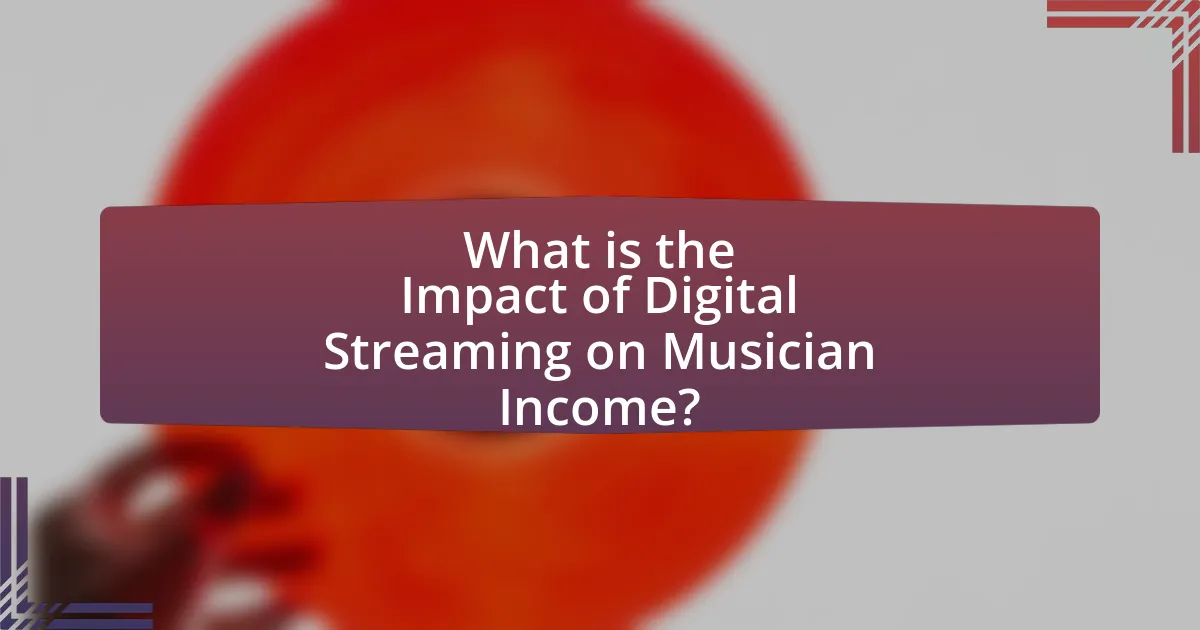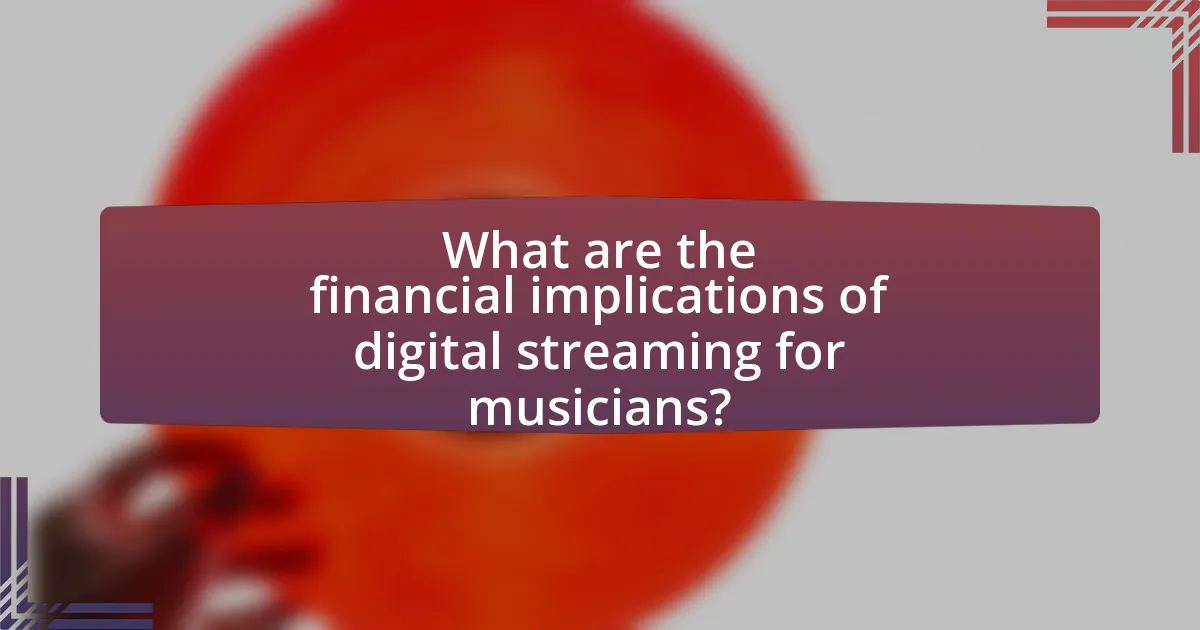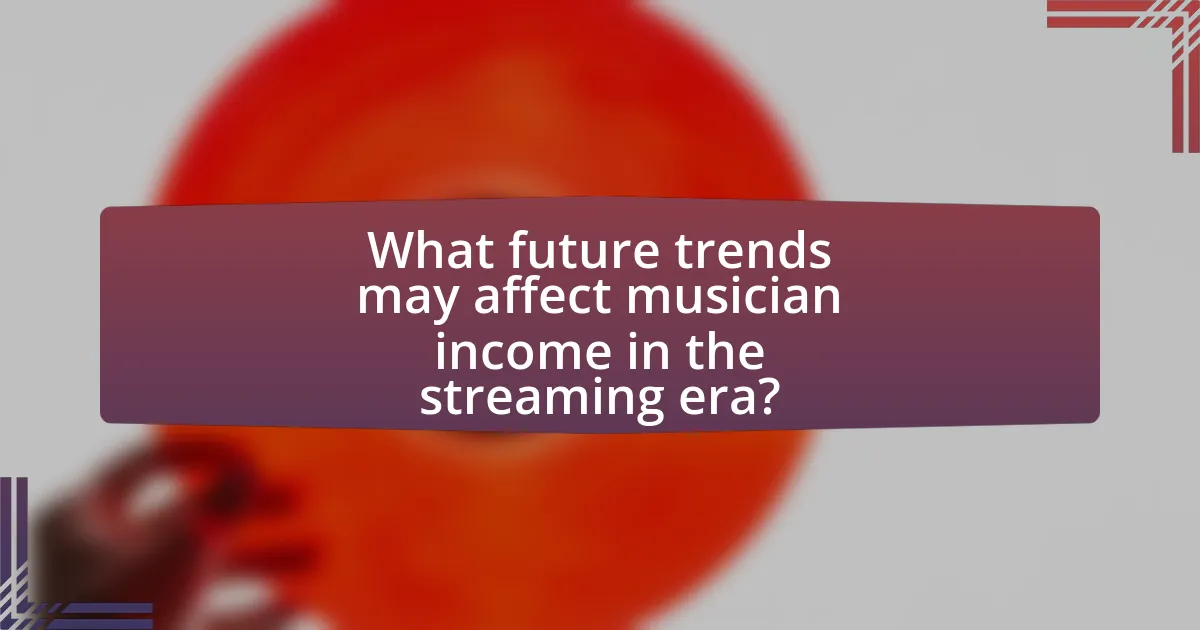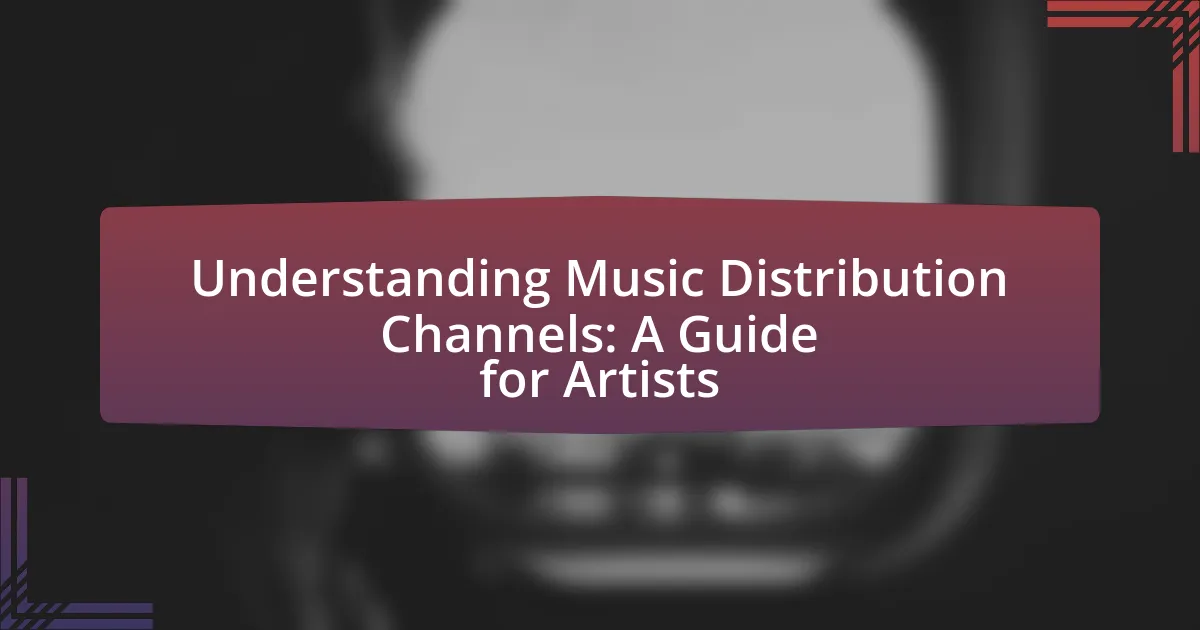The article examines the impact of digital streaming on musician income, highlighting the shift from traditional sales to streaming royalties. It discusses how platforms like Spotify and Apple Music dominate the market, accounting for a significant portion of music industry revenue while offering low per-stream payouts that challenge artists’ financial sustainability. The article also explores the changing landscape of music monetization, the importance of audience engagement, and the need for musicians to diversify their income sources through live performances and merchandise sales. Additionally, it addresses the implications of technological innovations and evolving revenue models on the future of musician earnings in the digital age.

What is the Impact of Digital Streaming on Musician Income?
Digital streaming has significantly altered musician income, primarily by reducing revenue from traditional sales while increasing exposure and potential earnings through royalties. According to a 2021 report by the International Federation of the Phonographic Industry (IFPI), global recorded music revenues grew by 7.4% in 2020, largely driven by streaming, which accounted for 62.1% of total revenue. However, individual artists often receive a fraction of a cent per stream, leading to concerns about fair compensation. For example, Spotify pays artists between $0.003 and $0.005 per stream, which means a musician needs millions of streams to earn a sustainable income. This shift has prompted many musicians to diversify their income sources, including live performances and merchandise sales, to compensate for the lower per-stream payouts.
How has digital streaming changed the music industry landscape?
Digital streaming has fundamentally transformed the music industry landscape by shifting revenue models from physical sales to subscription and ad-supported streaming services. This transition has led to a significant increase in music accessibility, with platforms like Spotify and Apple Music allowing users to access vast libraries for a monthly fee or free with ads. According to the Recording Industry Association of America (RIAA), streaming accounted for 83% of the U.S. music industry’s revenue in 2021, highlighting its dominance over traditional sales methods. Additionally, this shift has altered how artists monetize their work, as streaming royalties are often lower per play compared to traditional album sales, prompting many musicians to seek alternative income sources such as live performances and merchandise sales.
What are the key platforms involved in digital streaming?
The key platforms involved in digital streaming are Spotify, Apple Music, Amazon Music, YouTube Music, and Tidal. These platforms dominate the digital streaming landscape, providing access to millions of songs and podcasts. For instance, as of 2023, Spotify has over 500 million active users, making it the largest music streaming service globally. Apple Music, with over 88 million subscribers, offers exclusive content and integrates seamlessly with Apple devices. Amazon Music, part of the Amazon ecosystem, has gained significant traction with its Prime membership benefits. YouTube Music leverages the vast user base of YouTube, while Tidal differentiates itself with high-fidelity audio quality and artist-centric features. Each platform plays a crucial role in shaping the music industry and influencing musician income through streaming royalties.
How do these platforms differ in their revenue models?
Digital streaming platforms differ in their revenue models primarily through their payment structures and monetization strategies. For instance, Spotify operates on a freemium model, offering both free ad-supported access and premium subscriptions, with artists receiving a share of revenue based on the number of streams. In contrast, Apple Music relies solely on a subscription model, providing artists with a more predictable revenue stream per subscriber, as they do not have a free tier. Additionally, platforms like YouTube utilize ad revenue sharing, where artists earn money based on ad views and engagement, which can vary significantly compared to the per-stream payouts of Spotify. These differences in revenue models directly impact how musicians earn income, with varying degrees of predictability and potential earnings based on user engagement and platform policies.
Why is understanding musician income important in the digital age?
Understanding musician income is crucial in the digital age because it directly influences how artists navigate their careers and financial sustainability. With the rise of digital streaming platforms, traditional revenue streams such as album sales have diminished, leading to a shift in how musicians earn money. For instance, a report by the Recording Industry Association of America (RIAA) indicates that streaming accounted for 83% of the U.S. music industry’s revenue in 2020, highlighting the need for musicians to adapt to this new landscape. Additionally, understanding income sources, including streaming royalties, live performances, and merchandise sales, allows musicians to make informed decisions about their business strategies and marketing efforts, ultimately impacting their long-term success.
What are the traditional income sources for musicians?
Traditional income sources for musicians include live performances, album sales, merchandise sales, and royalties from radio play and licensing. Live performances have historically been a primary revenue stream, with musicians earning significant income from concerts and tours. Album sales, although declining in the digital age, still contribute to income, particularly for established artists. Merchandise sales, such as T-shirts and other branded items, provide additional revenue, especially during tours. Royalties from radio play and licensing agreements for film, television, and advertisements also serve as important income sources, compensating musicians for the use of their music in various media.
How does digital streaming compare to these traditional sources?
Digital streaming offers musicians a different revenue model compared to traditional sources like physical sales and radio airplay. While traditional sources often provide upfront payments or royalties based on sales, digital streaming typically generates income through per-stream payouts, which are significantly lower. For instance, in 2020, the average payout per stream from platforms like Spotify was approximately $0.003 to $0.005, contrasting sharply with the higher margins associated with physical album sales, where artists could earn around $5 to $10 per album sold. This shift has led to a decline in overall income for many musicians, as streaming services dominate music consumption, accounting for over 80% of the music industry’s revenue in recent years.
What challenges do musicians face with digital streaming?
Musicians face significant challenges with digital streaming, primarily related to low revenue per stream. Streaming platforms typically pay artists fractions of a cent per stream, which can result in minimal income for musicians, especially those with smaller audiences. For instance, a report from the Digital Media Association indicates that the average payout per stream is around $0.004, meaning an artist would need millions of streams to earn a sustainable income. Additionally, the dominance of a few major platforms creates a competitive landscape where visibility is limited, making it difficult for independent musicians to gain traction. This reliance on algorithms for playlist placements further complicates their ability to reach new listeners, as these algorithms often favor established artists over emerging talent.
How do streaming royalties affect overall musician earnings?
Streaming royalties significantly reduce overall musician earnings compared to traditional revenue sources. In 2021, the average payout per stream from major platforms like Spotify was approximately $0.003 to $0.005, meaning a musician would need millions of streams to earn a sustainable income. For instance, an artist would require around 250,000 streams to earn just $1,000, highlighting the disparity between streaming income and previous models such as album sales, where artists could earn a higher upfront payment. This shift has led many musicians to diversify their income through live performances, merchandise sales, and crowdfunding, as reliance solely on streaming royalties often proves insufficient for financial stability.
What are the implications of low per-stream payouts?
Low per-stream payouts significantly reduce musicians’ income, leading to financial instability for many artists. As streaming platforms like Spotify and Apple Music dominate music consumption, the average payout per stream often falls below a cent, which means artists need millions of streams to earn a sustainable income. For instance, Spotify reportedly pays between $0.003 and $0.005 per stream, necessitating over 300,000 streams to earn just $1,000. This economic model disproportionately affects independent and emerging artists, who may struggle to gain visibility and revenue compared to established acts. Consequently, low payouts can discourage creativity and innovation in the music industry, as artists may prioritize commercial viability over artistic expression to achieve necessary streaming numbers.
How does digital streaming influence musician exposure and reach?
Digital streaming significantly enhances musician exposure and reach by providing global access to their music. Platforms like Spotify and Apple Music allow artists to distribute their work widely without the traditional barriers of physical media or geographic limitations. According to a 2021 report by the International Federation of the Phonographic Industry (IFPI), over 400 million people subscribed to paid streaming services, indicating a vast audience for musicians. This accessibility enables emerging artists to gain visibility alongside established acts, fostering a more diverse music landscape. Furthermore, streaming algorithms promote songs based on listener preferences, increasing the likelihood of discovery for lesser-known musicians.
What role does audience engagement play in musician income?
Audience engagement significantly influences musician income by directly affecting revenue streams such as concert ticket sales, merchandise purchases, and streaming royalties. Engaged audiences are more likely to attend live performances, where musicians earn a substantial portion of their income; for instance, live music accounted for 75% of the total revenue for artists in 2019, according to the Music Industry Report. Additionally, high engagement levels on social media platforms can lead to increased streaming numbers, as artists with active fan interactions often see a boost in their streaming metrics, which translates to higher royalty payments. Thus, the correlation between audience engagement and musician income is evident through both live performance revenue and digital streaming success.

What are the financial implications of digital streaming for musicians?
Digital streaming significantly reduces the income musicians earn per stream compared to traditional sales. For instance, platforms like Spotify pay artists between $0.003 and $0.005 per stream, which means a musician needs millions of streams to generate substantial revenue. In 2021, the Recording Industry Association of America reported that streaming accounted for 83% of the U.S. music industry’s revenue, highlighting its dominance. However, this model often favors major labels and established artists, leaving independent musicians struggling to earn a living wage. Consequently, while digital streaming provides broader access to audiences, it creates financial challenges for many musicians reliant on traditional income sources.
How do different genres of music fare in the streaming economy?
Different genres of music perform variably in the streaming economy, with pop and hip-hop leading in streaming numbers and revenue. According to the Recording Industry Association of America (RIAA), pop music accounted for 30% of total streaming revenue in 2022, while hip-hop followed closely with 25%. In contrast, genres like classical and jazz have significantly lower streaming figures, often comprising less than 5% of total streams. This disparity highlights how mainstream genres benefit from broader audience appeal and marketing strategies, while niche genres struggle to gain traction in the competitive streaming landscape.
What trends can be observed in genre-specific streaming revenues?
Genre-specific streaming revenues show a significant divergence, with certain genres experiencing higher growth rates than others. For instance, hip-hop and pop have consistently led in streaming revenue, driven by their widespread popularity and strong listener engagement on platforms like Spotify and Apple Music. According to the Recording Industry Association of America (RIAA), hip-hop accounted for 28.2% of total music revenue in 2020, reflecting its dominance in the streaming landscape. Conversely, genres like classical and jazz have seen slower growth, often attributed to a smaller, more niche audience. This trend indicates that mainstream genres are capitalizing on streaming’s reach, while less popular genres struggle to gain similar traction.
How do fan demographics impact streaming income?
Fan demographics significantly impact streaming income by influencing listener engagement, subscription rates, and purchasing behavior. For instance, younger audiences, particularly those aged 18-34, are more likely to use streaming services, which correlates with higher streaming revenue for artists targeting this demographic. According to a report by the Recording Industry Association of America (RIAA), streaming accounted for 83% of the music industry’s revenue in 2020, largely driven by the preferences of younger listeners who favor digital platforms over physical sales. Additionally, demographic factors such as geographic location and cultural background can affect the types of music consumed, further shaping the income generated from streaming. For example, artists with a strong following in urban areas may see higher streaming numbers compared to those in rural regions, as urban populations tend to have greater access to high-speed internet and streaming services.
What are the potential benefits of digital streaming for musicians?
Digital streaming offers musicians increased exposure and access to a global audience, which can lead to higher income opportunities. With platforms like Spotify and Apple Music, artists can reach millions of listeners without the need for traditional distribution channels. According to a 2021 report by the International Federation of the Phonographic Industry, streaming accounted for 62% of the global recorded music revenue, highlighting its significance in the industry. Additionally, digital streaming allows musicians to monetize their work through royalties, merchandise sales, and concert promotions, creating multiple revenue streams.
How can musicians leverage streaming platforms for marketing?
Musicians can leverage streaming platforms for marketing by utilizing playlist placements, engaging with fans through social media integration, and analyzing listener data to tailor their promotional strategies. Playlist placements on platforms like Spotify can significantly increase visibility, as songs featured in popular playlists can reach millions of listeners, leading to higher streaming numbers and potential fan conversion. Engaging with fans through social media channels linked to streaming profiles fosters a community and encourages sharing, which amplifies reach. Additionally, analyzing listener data provided by streaming services allows musicians to understand their audience demographics and preferences, enabling targeted marketing efforts that can enhance their overall income from digital streaming.
What opportunities exist for direct fan support through streaming?
Direct fan support through streaming is facilitated by platforms that allow fans to contribute financially to artists, such as Patreon, Bandcamp, and Twitch. These platforms enable musicians to receive direct payments from fans in exchange for exclusive content, merchandise, or experiences. For instance, Bandcamp allows artists to set their own prices for music and merchandise, with a significant portion of sales going directly to the artist, which can enhance their income compared to traditional streaming royalties. Additionally, Twitch offers features like subscriptions and donations during live streams, providing artists with real-time financial support from their audience. This model has been increasingly adopted, as evidenced by a 2021 report from the Music Industry Association, which highlighted a 30% increase in direct fan contributions to artists through these platforms.
What strategies can musicians adopt to maximize income from streaming?
Musicians can maximize income from streaming by diversifying their revenue streams, engaging with their audience, and optimizing their distribution strategies. Diversification includes leveraging multiple platforms such as Spotify, Apple Music, and Bandcamp, which allows musicians to reach different audiences and benefit from varying payout structures. Engaging with audiences through social media and live streaming events can enhance fan loyalty and encourage direct support, such as merchandise sales or crowdfunding. Additionally, optimizing distribution by using services like DistroKid or TuneCore can ensure that music is available on as many platforms as possible, increasing potential earnings. According to a 2021 report by the Music Industry Association, artists who actively engage with fans and utilize multiple platforms can see up to 30% higher income from streaming compared to those who rely solely on one service.
How can musicians effectively promote their music on streaming platforms?
Musicians can effectively promote their music on streaming platforms by utilizing social media marketing, engaging with fans, and leveraging playlist placements. Social media platforms like Instagram, TikTok, and Twitter allow musicians to share snippets of their music, behind-the-scenes content, and personal stories, which can increase audience engagement and drive traffic to their streaming profiles. Engaging with fans through comments, live sessions, and Q&A can foster a loyal community, encouraging listeners to share the music further. Additionally, securing placements on popular playlists can significantly boost visibility; for instance, tracks featured on Spotify’s “Today’s Top Hits” playlist can see millions of streams, demonstrating the impact of strategic playlisting on listener reach and income potential.
What role does social media play in enhancing streaming income?
Social media significantly enhances streaming income by providing musicians with a platform to promote their work and engage with fans directly. Through social media channels, artists can share new releases, behind-the-scenes content, and personal stories, which fosters a deeper connection with their audience. This engagement often translates into increased streaming numbers, as fans are more likely to listen to and share music from artists they feel connected to. For instance, a study by the International Federation of the Phonographic Industry (IFPI) in 2021 indicated that 70% of music listeners discover new music through social media platforms. This statistic underscores the critical role social media plays in driving streaming income for musicians.

What future trends may affect musician income in the streaming era?
Future trends that may affect musician income in the streaming era include the rise of artificial intelligence in music creation, changes in streaming platform revenue models, and the increasing importance of direct fan engagement through social media and crowdfunding. The integration of AI tools allows for the production of music at a lower cost, potentially saturating the market and driving down prices. Additionally, streaming platforms are exploring new revenue-sharing models, which could either benefit or disadvantage musicians depending on the structure. For instance, platforms like Spotify have been criticized for low payout rates, and any shift in this model could significantly impact artist earnings. Furthermore, as artists leverage social media to build direct relationships with fans, they may find new revenue streams through merchandise sales and exclusive content, which can enhance their overall income. These trends indicate a complex landscape where musician income will increasingly depend on adaptability and innovation in response to technological and market changes.
How might changes in technology impact streaming revenue models?
Changes in technology can significantly impact streaming revenue models by enabling new monetization strategies and altering consumer behavior. For instance, advancements in artificial intelligence and machine learning allow platforms to offer personalized content recommendations, which can increase user engagement and subscription rates. According to a report by PwC, the global music streaming market is projected to grow from $20 billion in 2020 to $34 billion by 2025, largely driven by technological innovations that enhance user experience. Additionally, the rise of blockchain technology could facilitate direct payments to artists, reducing reliance on traditional intermediaries and potentially increasing their share of revenue. These technological shifts not only reshape how revenue is generated but also influence how artists and platforms interact with audiences, ultimately affecting musician income.
What innovations are emerging in the digital music space?
Innovations emerging in the digital music space include artificial intelligence-driven music creation, blockchain technology for copyright management, and immersive audio experiences through spatial audio formats. Artificial intelligence is being utilized to compose music, analyze listener preferences, and enhance production quality, as seen in platforms like Amper Music and AIVA. Blockchain technology is revolutionizing how artists manage rights and royalties, providing transparency and efficiency in transactions, exemplified by initiatives like Audius and Ujo Music. Additionally, spatial audio formats, such as Dolby Atmos, are creating more engaging listening experiences, allowing artists to deliver music in a three-dimensional sound environment, which is increasingly adopted by streaming services like Apple Music and Tidal.
How could these innovations alter musician income dynamics?
Innovations in digital streaming platforms could significantly alter musician income dynamics by shifting revenue sources from traditional sales to streaming royalties. As streaming services like Spotify and Apple Music dominate music consumption, musicians increasingly rely on per-stream payments rather than album sales, which have declined by over 50% since the early 2000s. This transition can lead to lower overall income for many artists, particularly independent musicians, who may earn as little as $0.003 to $0.005 per stream. Furthermore, the algorithms used by these platforms often favor popular artists, creating a disparity where a small percentage of musicians receive the majority of streaming revenue, thereby exacerbating income inequality within the music industry.
What are the best practices for musicians navigating the streaming landscape?
Musicians should focus on building a strong online presence, engaging with their audience, and optimizing their music for streaming platforms. Establishing a robust social media strategy allows musicians to connect directly with fans, which can lead to increased streams and revenue. Additionally, utilizing data analytics provided by streaming services helps musicians understand listener demographics and preferences, enabling them to tailor their marketing efforts effectively.
Moreover, musicians should consider releasing singles regularly rather than full albums, as this can maintain listener interest and increase visibility on playlists. Collaborating with other artists can also expand reach and introduce music to new audiences. According to a report by the Music Industry Association, artists who actively engage with their fans on social media see a 30% increase in streaming numbers. These practices collectively enhance a musician’s ability to navigate the streaming landscape successfully.
How can musicians build a sustainable income through digital streaming?
Musicians can build a sustainable income through digital streaming by diversifying their revenue streams and engaging with their audience effectively. This involves not only distributing music on multiple streaming platforms like Spotify and Apple Music but also leveraging social media for promotion and fan interaction. According to a 2021 report by the International Federation of the Phonographic Industry, streaming accounted for 62% of global recorded music revenue, highlighting its significance. Additionally, musicians can enhance their income by offering exclusive content, merchandise, and live-streamed performances, which can create additional revenue opportunities beyond streaming royalties.
What resources are available for musicians to understand streaming economics?
Musicians can access various resources to understand streaming economics, including industry reports, online courses, and financial tools. Notable resources include the “Music Industry Report” by MIDiA Research, which provides insights into streaming revenue trends and market analysis. Additionally, platforms like Coursera and Udemy offer courses on music business and digital distribution, helping musicians grasp the financial aspects of streaming. Financial tools such as Soundcharts and Chartmetric allow musicians to analyze their streaming data and understand their earnings better. These resources collectively equip musicians with the knowledge needed to navigate the complexities of streaming economics effectively.





